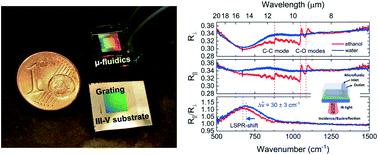当前位置:
X-MOL 学术
›
React. Chem. Eng.
›
论文详情
Our official English website, www.x-mol.net, welcomes your feedback! (Note: you will need to create a separate account there.)
Microfluidic surface-enhanced infrared spectroscopy with semiconductor plasmonics for the fingerprint region
Reaction Chemistry & Engineering ( IF 3.9 ) Pub Date : 2019-11-15 , DOI: 10.1039/c9re00350a Mario Bomers 1, 2, 3, 4, 5 , Benoît Charlot 1, 2, 3, 4, 5 , Franziska Barho 1, 2, 3, 4, 5 , Antoine Chanuel 1, 2, 3, 4, 5 , Aude Mezy 5, 6, 7 , Laurent Cerutti 1, 2, 3, 4, 5 , Fernando Gonzalez-Posada 1, 2, 3, 4, 5 , Thierry Taliercio 1, 2, 3, 4, 5
Reaction Chemistry & Engineering ( IF 3.9 ) Pub Date : 2019-11-15 , DOI: 10.1039/c9re00350a Mario Bomers 1, 2, 3, 4, 5 , Benoît Charlot 1, 2, 3, 4, 5 , Franziska Barho 1, 2, 3, 4, 5 , Antoine Chanuel 1, 2, 3, 4, 5 , Aude Mezy 5, 6, 7 , Laurent Cerutti 1, 2, 3, 4, 5 , Fernando Gonzalez-Posada 1, 2, 3, 4, 5 , Thierry Taliercio 1, 2, 3, 4, 5
Affiliation

|
The combination of semiconductor plasmonics with microfluidics allows surface-enhanced infrared spectroscopy of molecules in the flow regime. Exploiting semiconductor plasmonics enables surface-enhanced mid-IR spectroscopy from 4 μm to 20 μm and accesses the so-called molecular fingerprint region from 6.7 μm to 20 μm (1500–500 cm−1). Besides addressing the whole fingerprint region and allowing the identification of molecules by database comparison, the III–V semiconductor material class allows potentially an integration of semiconductor-based IR-sources, IR-detectors and IR-resonators on-chip. Miniaturized plasmonic enhanced microfluidic mid-IR spectrometry has great potential to analyse and identify minute amounts of molecules in the flow regime. This work describes technological processing to combine semiconductor plasmonics and microfluidics. Two proof-of-concept prototypes were experimentally realized and subsequently tested. Measured mid-IR spectra allow to clearly distinguish ethanol and water by their respective IR-absorption characteristics when inserted into the microfluidic flow chamber. Additionally, a semiconductor surface plasmon resonance shift can be observed according to the inserted solvent. Finally, the formation of a self-assembled monolayer under flow conditions is demonstrated by an observable mid-IR surface plasmon resonance shift of 6 ± 1 cm−1 (140 ± 23 nm).
中文翻译:

具有半导体等离子体的指纹识别区域的微流体表面增强红外光谱
半导体等离激元与微流控技术的结合可以使分子在流动状态下得到表面增强的红外光谱。利用半导体等离激元可以实现从4μm到20μm的表面增强中红外光谱,并进入从6.7μm到20μm(1500-500 cm -1)的所谓分子指纹区)。除了寻址整个指纹区域并允许通过数据库比较识别分子外,III–V类半导体材料类别还可以潜在地将基于半导体的IR源,IR检测器和IR谐振器集成在芯片上。小型等离激元增强型微流体中红外光谱仪具有巨大的潜力,可以分析和识别流态中的微量分子。这项工作描述了将半导体等离激元学和微流体学相结合的技术处理。通过实验实现了两个概念验证原型,然后进行了测试。当插入微流室时,测得的中红外光谱可以通过它们各自的红外吸收特性清楚地区分乙醇和水。此外,根据所插入的溶剂,可以观察到半导体表面等离振子共振位移。最后,通过观察到的中红外表面等离子体激元共振位移为6±1 cm,证明了在流动条件下自组装单层的形成-1(140±23纳米)。
更新日期:2019-11-15
中文翻译:

具有半导体等离子体的指纹识别区域的微流体表面增强红外光谱
半导体等离激元与微流控技术的结合可以使分子在流动状态下得到表面增强的红外光谱。利用半导体等离激元可以实现从4μm到20μm的表面增强中红外光谱,并进入从6.7μm到20μm(1500-500 cm -1)的所谓分子指纹区)。除了寻址整个指纹区域并允许通过数据库比较识别分子外,III–V类半导体材料类别还可以潜在地将基于半导体的IR源,IR检测器和IR谐振器集成在芯片上。小型等离激元增强型微流体中红外光谱仪具有巨大的潜力,可以分析和识别流态中的微量分子。这项工作描述了将半导体等离激元学和微流体学相结合的技术处理。通过实验实现了两个概念验证原型,然后进行了测试。当插入微流室时,测得的中红外光谱可以通过它们各自的红外吸收特性清楚地区分乙醇和水。此外,根据所插入的溶剂,可以观察到半导体表面等离振子共振位移。最后,通过观察到的中红外表面等离子体激元共振位移为6±1 cm,证明了在流动条件下自组装单层的形成-1(140±23纳米)。



























 京公网安备 11010802027423号
京公网安备 11010802027423号